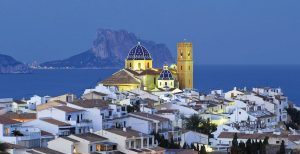Altea is one of the most beautiful and sustainable towns in Spain. Its old town and its viewpoint are enormously known for their charm. Many of its streets are paved and walking through them you can see a large number of restaurants and hotels. The ‘Plaça de l’Esglesia’ is the heart of Altea, an authentic center of leisure and culture.


Altea is a charming town and not in vain has several attractions considered of Cultural Interest:
‘PORTAL VELL’: ‘Portal Vell’ or ‘Puerta de Valencia’, open to the royal way to the north of the wall. In XVII Century The Main Street unites the ‘Portal Vell’ with the ‘Plaça de l’Esglesia’. It is preserved today with its unchanged layout. At the end, on the right, we observe the union of the original temple with the new Church.
‘CALLE SALAMANCA’: Buildings of interest can be found at numbers 1 and 3 of the street. At No. 5, the building preserves practically intact the typology of the second half of the eighteenth and early nineteenth centuries, corresponding to the wealthy local bourgeoisie. The house is in use and in very good condition.
‘GLORIETA DEL MAÑO’: Next to the bastion, in the northeast corner, was the House of the Lordship that dominated with its fire the mouth of the Algar River. Today the Glorieta del Maño, with panoramic views, takes its place.
‘CALLE FONDO’: In ‘Calle Fondo’ No. 8, the building that maintains the foundational parceling of the eighteenth century is attached to the wall, without perforations in it. Also of interest is the building on ‘Calle Concepción’ nº 5, where an oven from the founding era has been discovered.
‘PORTAL NOU / PLAZA CARMELINA SÁNCHEZ CUTILLAS’: ‘Portal Nou’ is the second of the two doors that remain. Also called ‘Puerta del Mar’, it opens in the mid-eighteenth century given the importance of the ‘Rabal Marinero’, at the inflection point of the Levante canvas. Attached to the ‘Portal’, is ‘Plaça de Carmelina Sánchez Cutillas’. With it, Altea pays tribute to the writer Altea of the generation of 50, who brought the fantastic world of letters to the streets of the town through the book ‘Matèria de Bretanya’.
‘PLAÇA DE FRANCESC MARTINEZ I MARTINEZ’: In the southeast corner of the bulwark was the ‘Casa del Comú i Justícia’. Today the ‘Plaça de Francesc Martínez i Martínez’ honors the figure of the illustrious ‘Alteano’ historian.
‘CALLE SANTA BÁRBARA’: As a singular building, inside the complex, there is the facade of the Cervantes House. House built by D. Francisco Martínez Martínez, member of the Renaissance Valenciana of the early twentieth century and eminent scholar of the work of Miguel de Cervantes.
‘PLAÇA DE L’ESGLESIA’: Space occupied by the Altea Castle, with a square body, with three sentry boxes at the corners. In the fourth corner, an emerging rhombus was added and finished in an arrowhead to defend the castle’s access door. From its vantage point, we feel an active part of History, involved in the past of our people.
‘CALLE CURA CREMADES’: In the southwest corner of the bastion was the ‘Portal del Castell’ or ‘Polop’, open to the West. ‘Calle Cura Cremades’ owes its name to the parish priest who made possible the construction of the Parochial Temple: Juan Bautista Cremades Peiró, who knew how to combine the efforts of all the ‘Alteanos’ to build the Church that predominates on the top of the hill and that is a main part of the silhouette of Altea.




